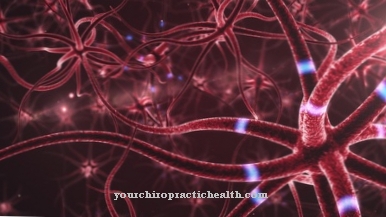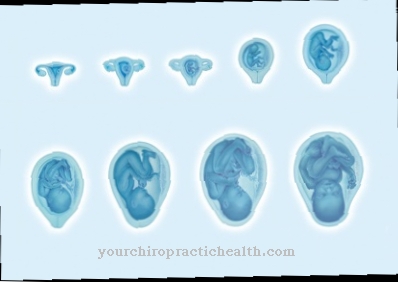Under the sensitivity medicine understands the perception of humans. This includes feeling and sensitivity.
What is the sensitivity?

Physicians describe sensitivity as the ability to perceive different sensations. This ability primarily involves feeling. In addition, the term sensitivity is also used for the basic sensitivity of the psychological and physical systems of the body. If there is increased sensitivity, it is called idiosyncrasy.
The term sensibility comes from the Latin word "sensibilis". Translated it means something like "connected with perception, sensation and senses" or "capable of feeling" when the term refers to humans. Since every person is born with sensory abilities, it is a fundamentally sensitive being.
Ultimately, psychological sensitivity depends on how people perceive their environment and how their perception filters are developed within the brain. Ups and downs in life can also play a role.
Function & task
Sensitivity is a complex performance of the human nervous system. Sensitive perceptions can be divided into quality and quantity. In higher centers of the central nervous system (CNS) they result in subjective sensations. The sensitivity is influenced by intra-individual and inter-individual fluctuations. This means that people perceive the same stimuli in different ways.
According to physiological and anatomical aspects, the sensitivity is divided into different areas. However, there is sometimes considerable overlap. For example, the subdivision is based on the location of the stimulus generation. This includes the perception of external stimuli through the skin and mucous membrane (see also exteroception) and the perception of internal stimuli (interoception). The latter perception can be divided into the perception of stimuli that originate from the internal organs (visceroception) and the perception of states of movement and tension in the musculoskeletal system (proprioception).
Further criteria are the location of the stimulus reception, such as surface and depth sensitivity and the type of stimuli transmitted, such as the fine perception of touch, pressure and vibrations (epicritical sensitivity) or the rough perception of temperatures and pain (protopathic sensitivity).
In addition, a differentiation is made between the type of receptors such as the thermal reception of cold and heat, the mechanoreception of pressure, touch and stretching, the chemoreception of carbon dioxide partial pressure, oxygen partial pressure or pH value, the nociception of pain or the direction of perception. This can in turn be divided into a haptic and a tactile perception. In haptic perception, an object is actively felt, while in tactile perception it is about the passive perception of touch. These roughly categorized forms of sensitivity can be attributed to leading anatomical structures and special physiological processes.
Sensitive stimuli are picked up by certain nerve endings to which u. a. count the Merkel cells, muscle spindles and Ruffini bodies. The nerves transmit the stimuli towards the dorsal root of the spinal ganglion. From this place the sensitive stimuli reach higher centers like the cerebral cortex and the thalamus via the spinal cord. Various spinal cord tracts are responsible for transmitting the sensitive stimuli from the outside to the central nervous system. These include the anterior spinocerebellar tract, the posterior spinocerebellar tract, the anterior spinothalamic tract, the lateral spinothalamic tract and the posterior funiculus.
You can find your medication here
➔ Medicines for paresthesia and circulatory disordersIllnesses & ailments
If there are pathological loss of sensitivity, doctors speak of sensitivity disorders. This means neurological symptoms that cause partial or complete loss of sensitivity. Sensitivity disorders can express themselves very differently. So it is possible that the sensation of pain, touch, temperature, movement, vibration, position and force is impaired.
The most common sensory disorders include qualitative changes. This term includes abnormal sensations such as an electrifying feeling, tingling or furiness. The disorders usually show up in the areas supplied by individual nerves or stump-like at the ends of the limbs. Responsibility for this form of sensitivity disturbance is mostly an over-excitability of nerve fibers or sensitive receptors.
Qualitative changes are divided into dysesthesia and paresthesia. With dysesthesia, those affected find the perceptions unpleasant. Paresthesia causes unpleasant or even painful sensations without a specific triggering stimulus being present.
The sensitive perception can also decrease or fail completely. The patients no longer perceive any sensations in the affected areas. A total failure is called anesthesia, which in turn can be subdivided into analgesia (removal of pain sensitivity), thermal anesthesia (removal of temperature sensitivity) and pallanesthesia (loss of vibration perception).
Disorders in which a weakening of the sensitivity perception occurs are called hypesthesia or decreased tactile perception. Hypalgesia (reduction in pain perception), thermhypesthesia (reduced sensitivity to temperature) or pallhypesthesia (reduction in vibration perception) are known as subforms. In the case of a dissociated sensory disorder, there is an impairment of the pain and temperature sensation in a certain area of the skin. The person concerned only perceives pain as touch or pressure.
However, it is also possible that sensitivity disorders lead to increased awareness. This includes, for example, allodynia. The affected people suffer from pain caused by stimuli that normally do not lead to pain.With hyperalgesia, there is an increased sensitivity to pain, so that even minor stimuli cause pain. In the context of hyperpathy, the patient perceives touch stimuli as unpleasant. If there is an increased sensitivity to touch, it is referred to as hyperesthesia.



























